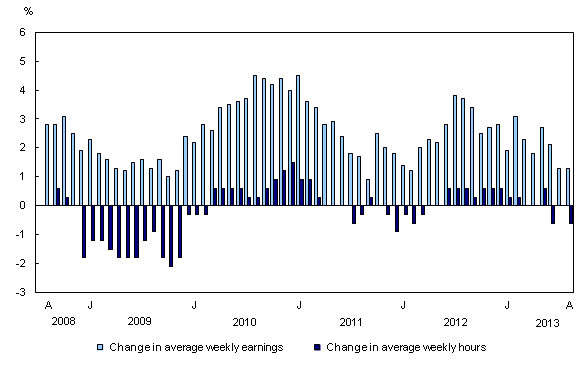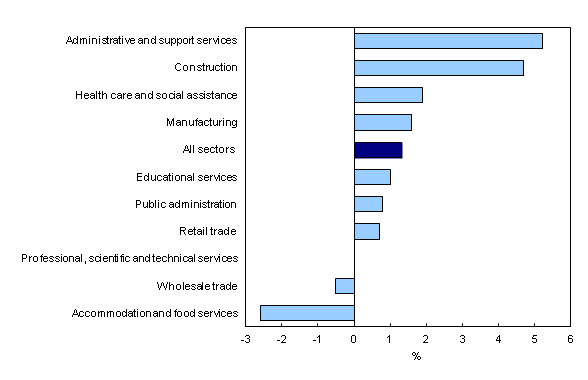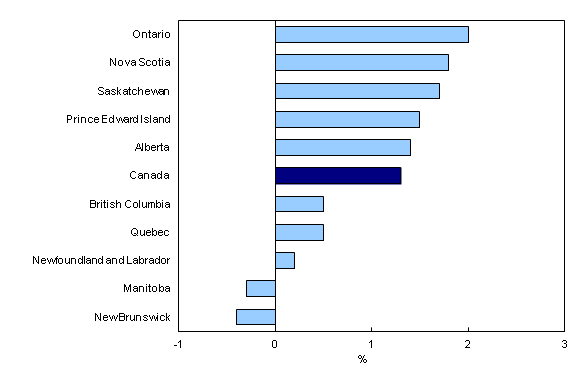Payroll employment, earnings and hours, August 2013
Archived Content
Information identified as archived is provided for reference, research or recordkeeping purposes. It is not subject to the Government of Canada Web Standards and has not been altered or updated since it was archived. Please "contact us" to request a format other than those available.
Released: 2013-10-31
Average weekly earnings of non-farm payroll employees were $918 in August, up 0.4% from the previous month. On a year-over-year basis, weekly earnings increased 1.3%.
The 1.3% increase in weekly earnings during the 12 months to August reflected a number of factors, including wage growth, changes in the composition of employment by industry, occupation and level of job experience, as well as average hours worked per week. Non-farm payroll employees worked an average of 32.9 hours per week in August, down from 33.0 hours in July and also down from the August 2012 average of 33.1 hours.
Average weekly earnings by sector
Year-over-year growth in average weekly earnings outpaced the national average in four of the largest industrial sectors, led by administrative and support services as well as construction.
Compared with 12 months earlier, average weekly earnings in administrative and support services increased 5.2% to $760 in August. Several industries in this sector posted earnings increases over the 12 months, including employment services; services to building and dwellings; business support services; and office administrative services.
Average weekly earnings grew by 4.7% in construction to $1,203. This was mainly a result of growth in heavy and civil engineering construction as well as construction of buildings.
In the 12 months to August, weekly earnings in health care and social assistance rose by 1.9% to $827, with all of the gains taking place from August to November 2012. Earnings in hospitals increased throughout the 12 months to August, and ambulatory health care services saw its earnings rise over the first five months of the period.
After reaching a high of $374 in August 2012, average weekly earnings in accommodation and food services declined by 2.6% to $364 in the 12 months to August. During this period, employment was up in this sector, while average hours worked decreased. The earnings decline was in traveller accommodation as well as full-service restaurants and limited-service eating places.
Average weekly earnings by province
Year-over-year earnings growth of non-farm payroll employees was above the national average in five provinces. At the same time, earnings in Manitoba and New Brunswick edged down.
Average weekly earnings in Ontario rose 2.0% to $931, with gains spread across many sectors. This was only the second time in the past three years that year-over-year earnings growth in the province was higher than the national average.
Compared with 12 months earlier, average weekly earnings in Nova Scotia grew by 1.8% to $809. There was notable earnings growth in administrative and support services; retail trade; finance and insurance; educational services; and manufacturing.
In Saskatchewan, average weekly earnings increased 1.7% to $955 in the 12 months to August, with growth in most sectors.
Average weekly earnings in Prince Edward Island rose 1.5% to $761 in the 12 months to August. Earnings in this province have been on an upward trend since January 2013.
Despite edging down compared with August 2012, average weekly earnings in New Brunswick and Manitoba have been relatively flat over the year.
Non-farm payroll employment by sector
Total non-farm payroll employment rose by 51,300 in August, following an increase of 71,200 in July. In August, the number of payroll employees rose in all the largest industrial sectors.
In the 12 months to August, the number of non-farm payroll employees increased by 119,300 or 0.8%. All of the gains occurred in the last two months, as employment was relatively flat from August 2012 to June 2013.
Among all sectors, real estate and rental and leasing posted the highest 12-month growth rate in payroll employment at 4.4%, with most of the gains occurring since December 2012. Employment growth rates from August 2012 to August 2013 were also notable in construction (+4.1%), and in accommodation and food services (+3.8%), a sector that has been on an upward trend since early 2011.
Since August 2012, employment has declined markedly in information and culture (-4.5%), with the bulk of the losses occurring from August to October 2012. There was also a notable decline in manufacturing (-1.0%), with all of the losses taking place from March to July.
Note to readers
The Survey of Employment, Payrolls and Hours (SEPH) is produced by a combination of a census of payroll deductions, provided by the Canada Revenue Agency, and the Business Payrolls Survey (BPS), which collects data from a sample of 15,000 establishments. Its key objective is to provide a monthly portrait of the level of earnings, the number of jobs and hours worked by detailed industry at the national, provincial and territorial level.
Estimates of average weekly earnings and hours are based on a sample and are therefore subject to sampling variability. Payroll employment estimates are based on a census of administrative data and are not subject to sampling variability.
Statistics Canada also produces employment estimates from its monthly Labour Force Survey (LFS). The LFS is a household survey, the main objective of which is to divide the working-age population into three mutually exclusive groups: the employed (including the self-employed), unemployed and not in the labour force. This survey is the official source for the unemployment rate and collects data on the socio-demographic characteristics of all those in the labour market.
As a result of conceptual and methodological differences, estimates of changes from SEPH and LFS do differ from time to time. However, the trends in the data are quite similar.
Unless otherwise stated, this release presents seasonally adjusted data, which facilitates comparisons by removing the effects of seasonal variations. For more information on seasonal adjustment, see Seasonal adjustment and identifying economic trends.
Non-farm payroll employment data are for all hourly and salaried employees, as well as the "other employees" category, which includes piece-rate and commission-only employees.
Average weekly hours data are for hourly and salaried employees only and exclude businesses that could not be classified to a North American Industry Classification System (NAICS) code.
All earnings data include overtime pay and exclude businesses that could not be classified to a NAICS code. Earnings data are based on gross taxable payroll before source deductions. Average weekly earnings are derived by dividing total weekly earnings by the number of employees.
With each release, data for the current reference month are subject to revision. Data have been revised for the previous month. Users are encouraged to request and use the most up-to-date data for each month.
Data on the education sector
Changes in payroll employment in education during the summer months can be affected by changes in payment schedules and school-year calendars. Month-to-month and year-over-year movements should therefore be interpreted with caution, and more attention given to long-term trends.
Guide to the Survey of Employment, Payrolls and Hours
This guide is now available on the Statistics Canada website (Catalogue number72-203-G). It covers topics such as survey methodology, data collection, processing, and data quality. It also contains a dictionary of concepts and definitions, provides a list of products and services as well as the survey questionnaires.
CANSIM changes
As of the September 27 release, data in CANSIM tables 281-0023 to 281-0046 cover the period 2001 to present. At the same time, new tables were created for the time series prior to 2001.
Two new tables were created with data starting in 2001: Table 281-0048 (formerly 281-0031 and 281-0034) and Table 281-0063 (formerly 281-0025 and 281-0028). For a concordance vector table, or for more information on these changes, contact Labour Statistics Division Client services (toll-free 1-866-873-8788; labour@statcan.gc.ca).
As of this release, CANSIM tables 281-0050 and 281-0051 on payroll employment from 1991 to 2000 are available (formerly part of tables 281-0023 and 281-0024).
Data for 2001 onward on hourly earnings and payroll employment are now available in CANSIM tables CANSIM table281-0048 (formerly CANSIM table281-0031 and CANSIM table281-0034) and CANSIM table281-0063 (formerly CANSIM table281-0025 and CANSIM table281-0028).
Data for 1991 to 2000 on payroll employment are now available in CANSIM tables CANSIM table281-0050 and CANSIM table281-0051 (formerly CANSIM table281-0023 and CANSIM table281-0024).
Definitions, data sources and methods: survey number survey number2612.
A data table is available from the Browse by key resource module of our website under Summary tables.
Data on payroll employment, earnings and hours for September will be released on November 27.
More information about the concepts and use of the Survey of Employment, Payrolls and Hours is available online in The Guide to the Survey of Employment, Payrolls and Hours (Catalogue number72-203-G), from the Browse by key resource module of our website under Publications.
Contact information
For more information, contact us (toll-free 1-800-263-1136; 514-283-8300; infostats@statcan.gc.ca).
To enquire about the concepts, methods or data quality of this release, contact Emmanuelle Bourbeau (613-951-3007; emmanuelle.bourbeau@statcan.gc.ca), Labour Statistics Division.
- Date modified:




